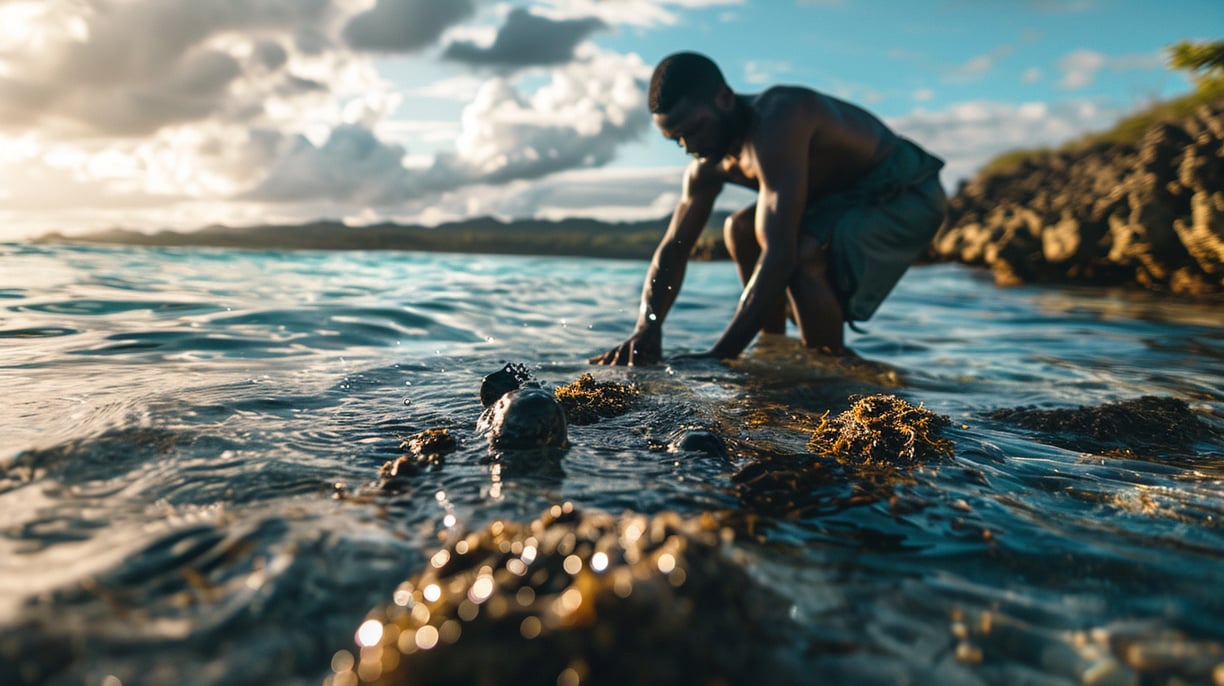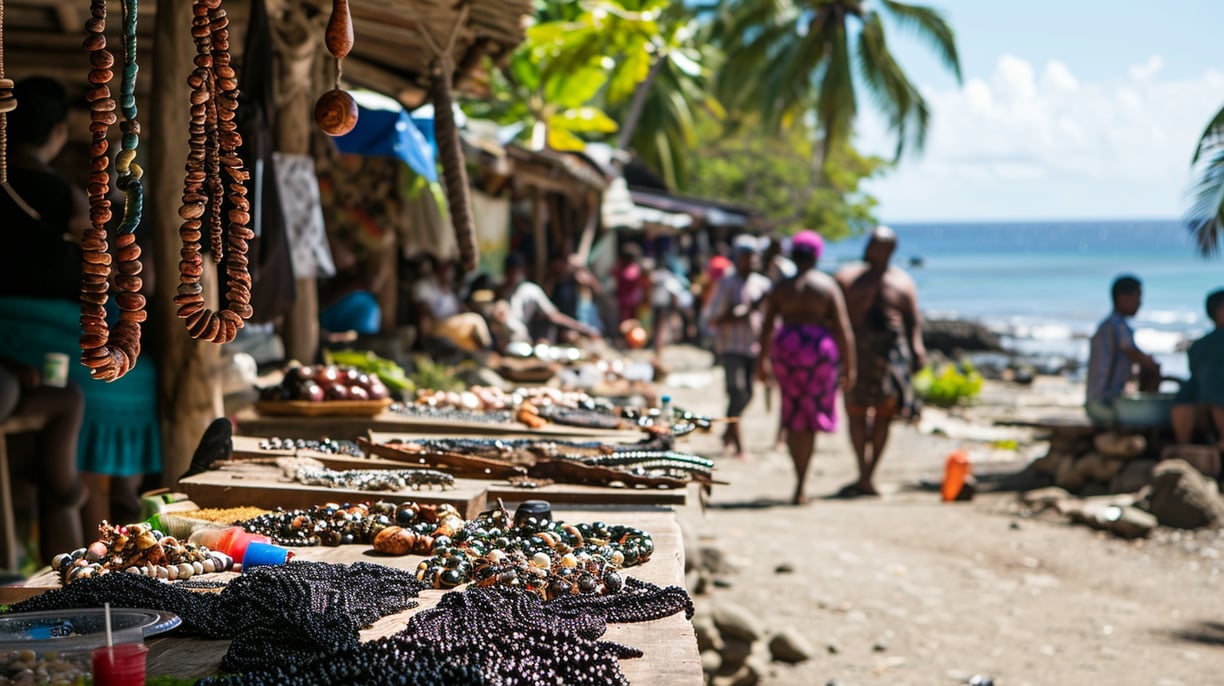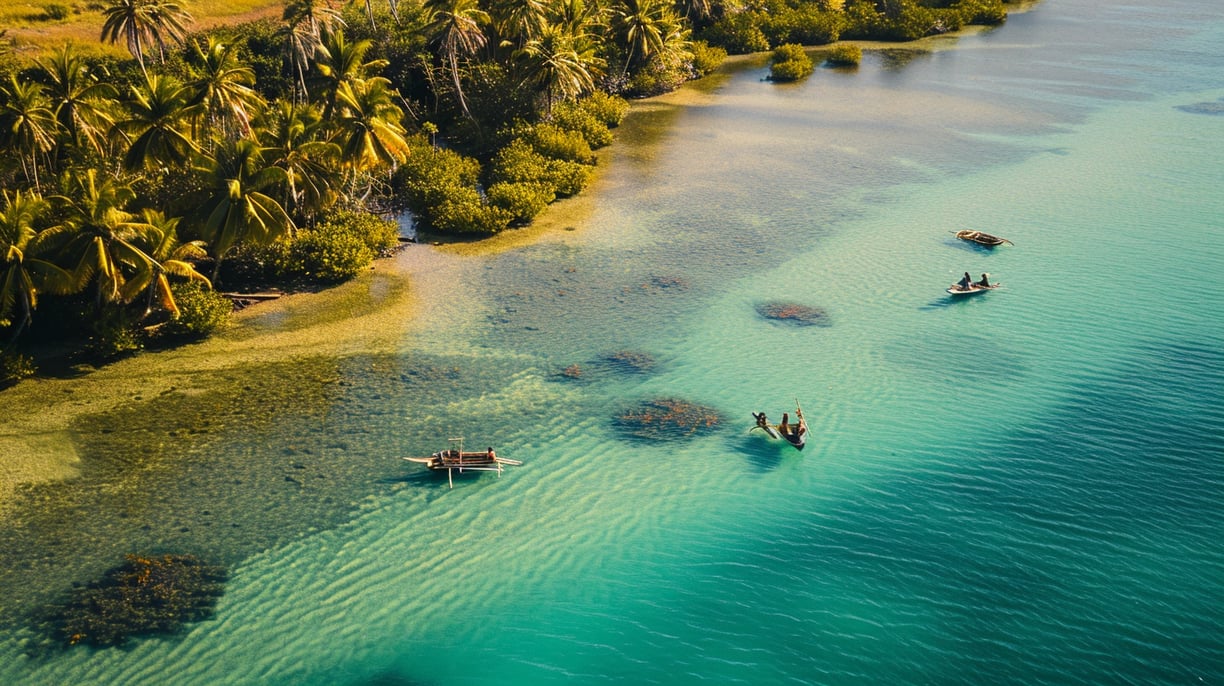Black Pearls and Their Mystique: A Deep Dive into Manihiki's Treasures
Explore the enchanting world of Manihiki's black pearls, diving into the lustrous mystique of these oceanic gems that capture the essence and beauty of the Cook Islands.

Black pearls, with their intriguing allure and undeniable beauty, have captured the imagination of people around the world. These exquisite gemstones, known for their unique color and luster, have a long-standing mystique that is deeply rooted in their rarity and value. In this article, we will take a deep dive into the captivating world of black pearls, with a special focus on the birthplace of these treasures - the enchanting island of Manihiki.
The Allure of Black Pearls
Black pearls have a certain magnetism that sets them apart from their white and colored counterparts. Their dark, iridescent hues ranging from deep charcoal to midnight black, coupled with their exquisite sheen, make them incredibly desirable. When draped around the neck or adorning the earlobes, black pearls exude a sense of elegance and sophistication that captivates both the wearer and the onlooker. Understanding the mystique surrounding black pearls is the key to appreciating their true beauty.
Black pearls, also known as Tahitian pearls, are formed within the Pinctada margaritifera oyster species. Unlike other mollusks, which create pearls within a white or translucent hue, this particular oyster produces pearls with dark pigmentation. This unique characteristic gives black pearls their distinctive color. The formation of a black pearl is a complex process that involves various factors such as the genetics of the oyster, the surrounding environment, and the presence of minerals in the water.
One fascinating aspect of black pearls is the role of genetics in their formation. The Pinctada margaritifera oyster species carries specific genes that contribute to the creation of black pearls. These genes determine the pigmentation of the pearl, resulting in the mesmerizing dark hues that make black pearls so alluring. The interplay between genetics and environmental factors creates a delicate balance that gives each black pearl its unique color and shine.
The surrounding environment also plays a crucial role in the formation of black pearls. The oysters that produce these pearls thrive in the pristine waters of the South Pacific, particularly in places like French Polynesia and the Cook Islands. These regions provide the perfect conditions for the growth of the Pinctada margaritifera oysters, with their nutrient-rich waters and ideal temperatures. The oysters absorb minerals from the surrounding environment, which become incorporated into the pearl, adding to its beauty and value.
The Rarity and Value of Black Pearls
Black pearls are considered to be among the rarest of all pearls, making them highly coveted by collectors and jewelry enthusiasts alike. Manihiki, known as one of the prime sources of black pearls, plays a significant role in determining their scarcity. Located in the remote Cook Islands, Manihiki is home to a limited number of oysters capable of producing black pearls. The process of farming and harvesting these pearls is a meticulous and time-consuming endeavor, further contributing to their rarity.
Each black pearl is a testament to the dedication and skill of the pearl farmers who carefully nurture the oysters. The process begins with the selection of healthy oysters, which are then placed in special underwater cages. These cages protect the oysters from predators and provide them with a controlled environment to grow. Over the course of several years, the oysters slowly develop the black pearls within their shells, with each pearl taking on its own unique characteristics.
Once the pearls have reached maturity, they are carefully harvested by skilled divers. The divers must navigate the depths of the ocean, braving the currents and potential dangers to retrieve these precious gems. The pearls are then painstakingly sorted and graded based on their size, shape, color, and luster. Only the finest black pearls make it to the market, where they are transformed into exquisite pieces of jewelry that showcase their natural beauty.
The allure of owning a piece of this natural treasure is undeniable. Black pearls symbolize rarity, elegance, and sophistication, making them a coveted addition to any jewelry collection. Whether worn as a statement necklace, a pair of earrings, or a stunning bracelet, black pearls have the power to captivate and mesmerize. Their dark, mysterious allure continues to fascinate and enchant jewelry enthusiasts around the world, ensuring their timeless appeal for generations to come.

The Birthplace of Black Pearls: Manihiki
The small island of Manihiki, located in the South Pacific Ocean, is renowned for being the birthplace of black pearls. Its unique geography and favorable climate make it an ideal habitat for the cultivation of these exquisite gems.
Geography and Climate of Manihiki
Situated in the Cook Islands, Manihiki is surrounded by the vast expanse of the Pacific Ocean. Its picturesque landscape, with crystal-clear turquoise waters and lush greenery, creates a serene backdrop for pearl farming. The island's isolation, far from the bustling cities and industrialization, allows for pristine conditions that contribute to the nurturing of high-quality black pearls.
The island of Manihiki is part of a larger group of islands known as the Northern Cook Islands. It is located approximately 1,299 miles northeast of the capital city of Rarotonga. Manihiki itself is a coral atoll, characterized by a ring-shaped reef enclosing a central lagoon. The lagoon is home to a diverse array of marine life, including the Pinctada margaritifera oyster, which produces the sought-after black pearls.
Manihiki's climate is tropical, with warm temperatures year-round. The island experiences a wet season from November to March, with frequent rainfall and occasional tropical storms. The rest of the year is relatively dry, with plenty of sunshine and gentle breezes. These climatic conditions, combined with the nutrient-rich waters of the Pacific Ocean, provide an optimal environment for the growth and development of black pearls.
The Pearl Farming Tradition
For centuries, the people of Manihiki have practiced the art of pearl farming, passing down their knowledge and expertise from generation to generation. The process begins with carefully selecting mature oysters from the surrounding lagoon and meticulously implanting a nucleus within their soft tissue. Over time, the oysters deposit layers of nacre around the nucleus, creating a lustrous pearl. This delicate process requires patience, skill, and a profound understanding of the oysters' needs.
The tradition of pearl farming on Manihiki is deeply rooted in the island's culture and history. The local community has developed a strong bond with the ocean and its resources, recognizing the importance of sustainable practices to ensure the long-term viability of pearl farming. The process of cultivating black pearls is not only a means of livelihood but also a way of preserving the island's cultural heritage.
Pearl farmers on Manihiki take great care in maintaining the health and well-being of the oysters. They monitor water quality, temperature, and nutrient levels to create an optimal environment for the oysters to thrive. Regular cleaning and maintenance of the oyster beds are also crucial to prevent the buildup of harmful organisms and ensure the oysters' overall health.
Once the pearls have reached maturity, they are carefully harvested and sorted based on their size, shape, color, and luster. Skilled artisans then transform these raw pearls into exquisite jewelry pieces, showcasing the natural beauty and elegance of Manihiki's black pearls.
The Journey of a Black Pearl
From the tranquil waters of Manihiki to the glamorous world of jewelry, the journey of a black pearl is a testament to its timeless beauty and the dedication of those involved in its production.
From Oyster to Jewelry
Once the pearls are harvested, they undergo a meticulous grading process to determine their quality, size, shape, and luster. Those deemed exceptional are carefully selected for use in jewelry designs. Skilled craftsmen and designers transform these exceptional pearls into pieces that showcase their inherent beauty, whether as earrings, necklaces, or bracelets. Each pearl tells a story, reflecting the dedication and artistry required to bring it to life.
The Role of Pearl Divers
Pearl divers play a vital role in the fascinating journey of black pearls. With their expert knowledge of the underwater ecosystem and the needs of the oysters, they venture into the depths of the lagoon to care for and nurture these delicate creatures. Their skillful hands extract the mature pearls and ensure the sustainability of the oyster population, ensuring that the legacy of black pearls continues for generations to come.

The Cultural Significance of Black Pearls
Black pearls hold significant cultural value, particularly in the Polynesian culture from which they hail. In traditional Polynesian society, black pearls symbolize prosperity, spirituality, and divine connection.
Black Pearls in Polynesian Culture
For the Polynesian people, black pearls hold deep spiritual significance. They are believed to be gifts from the gods, embodying the connection between humans and the divine. Black pearls are often incorporated into ceremonial attire, worn during cultural celebrations, and passed down as family heirlooms, carrying the wisdom and heritage of generations.
Black Pearls in Global Fashion
The mesmerizing allure of black pearls has transcended cultural boundaries and reached the global stage of fashion. Today, these dark gems are coveted by influential designers and appreciated by individuals seeking to make a statement with their accessories. Black pearls have graced the red carpets, adorned the covers of prestigious magazines, and become a staple in high-end jewelry collections, leaving a lasting impression on the fashion world.
The Market for Black Pearls Today
The market for black pearls has witnessed significant growth in recent years, as their allure continues to captivate jewelry enthusiasts and investors alike.
Determining the Quality of Black Pearls
When evaluating black pearls, several factors come into play. The size, shape, surface quality, luster, and color of the pearl all contribute to its overall value. The most desired black pearls possess a deep color with a uniform and intense luster, showcasing the natural beauty and enchanting mystique of these gems.
Investing in Black Pearls
For those considering investing in black pearls, it is essential to research reputable sources and seek expert advice. The rarity and escalating demand for high-quality black pearls make them a potential long-term investment. As with any investment, understanding the market trends, evaluating the quality of the pearls, and investing wisely is crucial to ensure a valuable and rewarding venture.
Conclusion
Black pearls, with their enchanting allure and captivating mystique, have an undeniable attraction that transcends cultures and generations. The journey of a black pearl, from the depths of Manihiki's waters to its place on the world stage of fashion, is a testament to its enduring beauty and the skill and passion of those involved in its creation. Whether worn as a symbol of cultural heritage or a statement of personal style, black pearls hold a timeless allure that continues to enthrall and fascinate. So, why not take a dive into the mesmerizing world of black pearls and discover the treasures that await?